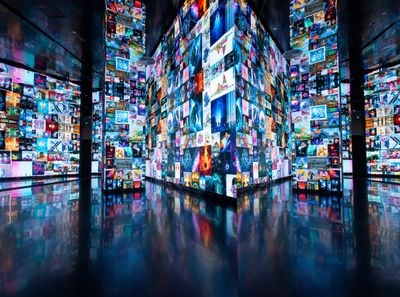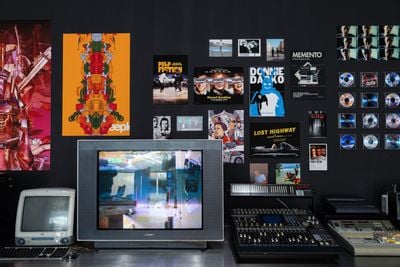
15 Nov Beeplemania Comes to China’s Deji Art Museum
Source Credit: Content and images from Ocula Magazine. Read the original article - https://ocula.com/magazine/art-news/beeplemania-comes-to-chinas-deji-art-museum/
At the opening of a major institutional show backed by Hans Ulrich Obrist, Beeple told Ocula, ‘as more people make money through digital means, I think you will see them natively drawn to collecting [digital] work.’

Beeple, Everydays (2007–ongoing). Exhibition view: Beeple: Tales from a Synthetic Future, Deji Art Museum, Nanjing (13 November 2024–late 2025). Courtesy Deji Art Museum.
Digital artist Beeple (Mike Winkelmann) announced the completion of his 6,406th piece in the ‘Everydays’ series to slightly lethargic cheers at the Deji Art Museum in Nanjing on 13 November.
For the past 17 years, the comp-sci major from Charleston has ritualistically created and shared a new artwork each day. At Deji, an institution backed by Chinese retail property developers Deji Group, the 40-minute creation process saw Beeple drag, drop, and tweak purchased or pre-made 3D models, culminating in a hamburger-eyed monument of the artist’s head surrounded by Insta-viral creatures—hippo Moo Deng, pokémon Pikachu, and Pepe the Frog.
Having built a following with the rise of NFTs, Beeple cemented a place in art market history in February 2021 when his digital collection Everydays: The First 5,000 Days sold to Singapore-based programmer Vignesh Sundaresan, also known as MetaKovan, for U.S. $69 million in an auction conducted in partnership between Christie’s and NFT platform MakersPlace.
His exhibition at Deji, Beeple: Tales from a Synthetic Future, which continues until late 2025, is backed by Serpentine Director Hans Ulrich Obrist, who served as the exhibition’s Senior Artistic Advisor. Alongside dynamic screens showing the ‘Everydays’ series are Beeple’s kinetic sculptures, including S.2122 (2023), which was acquired by the museum last year for a reported $9 million.
Beeple. Courtesy Deji Art Museum.
The market for NFTs fell 51% to 1.2 billion in 2023, according to a report by Art Basel and UBS, but Beeple continues to celebrate digital artwork, both abroad and back home in South Carolina, where he opened his own gallery and studio space in March 2023.
The price of Bitcoin has rallied spectacularly this year with the election of Donald Trump, who accepted crypto donations and promised to make the United States the ‘crypto capital of the planet’.
At this pivotal moment, Beeple shared his observations on art’s role in responding to current events, the future of AI in cultural production, and what’s in store for the digital art market.
You often satirise politicians like Donald Trump and tech CEOs like Elon Musk, Mark Zuckerberg, and Jeff Bezos. Do you see your art as having an inherent political bent?
No. I feel like most people’s art is more like propaganda in a way because it’s trying to convince you of a very specific viewpoint and say, ‘this is right and this is how you should think’. I’m much more interested in asking questions than giving answers, so the artwork is pretty ambiguous in its meaning. If you immediately understand the point of it, then I don’t think that has lasting depth.
Exhibition view: Beeple: Tales from a Synthetic Future, Deji Art Museum, Nanjing (13 November 2024–late 2025). Courtesy Deji Art Museum.
The speed with which you can create and disseminate digital art means that it can immediately react to the news and enter emerging debates. How does your work respond to current events?
Being able to create an artwork hours after something happens and then have it become a place for people to discuss, is quite new. I think there are many ways in which I could do a better job at engaging those possibilities. For instance, I should stream more of the Everydays being created because then people could not only comment on the finished piece but have a conversation while I’m making it.
There are people with a lot of wealth and power who have shown strong interest in digital art, including billionaire businessman Mark Cuban and venture capitalist Ryan Zurrer. How is the appetite for digital art changing?
As more people make money through digital means, I think you will see them natively drawn to collecting [digital] work. The idea that digital art could have significant value will change people’s perception of the canon of art.
That being said, it’s still going to be hyper-competitive to be an “artist”, to make whatever they want and have people pay for them. The best job in the world is gonna be hyper-competitive.
Exhibition view: Beeple: Tales from a Synthetic Future, Deji Art Museum, Nanjing (13 November 2024–late 2025). Courtesy Deji Art Museum.
What is the key to building an audience in the 21st century?
Patience, persistence, and finding a way to cut through the noise. Don’t try to assume what people want to see, and instead, focus on what you want to make. Passion is infectious.
AI seems poised to revolutionise art and cultural production. Will it? And if it does, what does the future look like?
We’re very much at the beginning of this [AI], which is crazy to say because I cannot even imagine what it will be like five years from now. There are two different ways to look at AI: if you look at it as a way for humans to do more, you will be inspired by it; if you look at it as a way for humans to do less, you will be fearful of it. That’s always been the case with technology. —[O]
Source Credit: Content and images from Ocula Magazine. Read the original article - https://ocula.com/magazine/art-news/beeplemania-comes-to-chinas-deji-art-museum/




